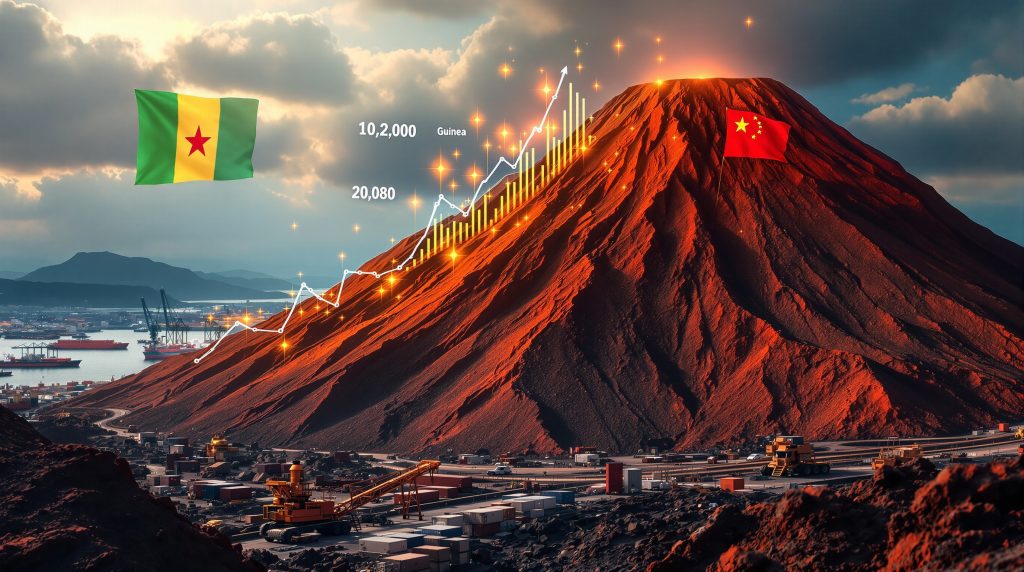Iron Ore Price Rally Surges on Simandou Supply Concerns and Chinese Demand
Iron ore futures have climbed for six consecutive sessions, primarily driven by mounting concerns regarding the giant Simandou project in Guinea, alongside expectations of improving demand in China's steel sector. The benchmark January iron ore contract on China's Dalian Commodity Exchange (DCE) recently closed 2.03% higher at 805 yuan ($112.98) per metric ton, touching its highest level since July 25. Similarly, the October iron ore contract on the Singapore Exchange rose 1.64% to $107.15 per ton, reaching its highest point since late February.
The rally represents a significant shift in market sentiment, as previous expectations suggested the Simandou project would place downward pressure on prices once operational. However, regulatory complications have transformed this outlook, contributing to the current price surge in iron ore price trends.
How Are Supply Concerns Affecting Iron Ore Prices?
The iron ore market's recent upward trajectory stems largely from growing uncertainty surrounding Guinea's massive Simandou project, which contains over two billion tonnes of high-grade iron ore reserves. This project, with its substantial annual production capacity of 120 million metric tons, represents approximately 8-10% of global seaborne iron ore trade when fully operational.
Recent developments suggest Guinea's government may require Rio Tinto to build a local refinery for processing ore before export—a requirement that would significantly alter the project's economics and timeline.
Simandou Project Complications
The potential requirement for local processing of Simandou ore would have far-reaching implications for global iron ore markets:
- Reduced export volumes as some material would be processed within Guinea
- Substantial increases in development costs (typically 30-50% higher for mining projects with processing requirements)
- Extended timeline before full production capacity is reached
- Uncertainty surrounding the project's overall economic viability
These complications align with Guinea's broader resource nationalism strategy, which aims to capture more value from natural resources by requiring in-country processing rather than simply exporting raw materials.
Production Timeline Uncertainties
While first shipments from Simandou were initially expected in November, the potential processing requirements create significant uncertainty about this timeline. Industry analysts note that similar requirements in Guinea's bauxite sector have already resulted in canceled mining deals due to delays in constructing alumina refineries.
The high-grade nature of Simandou's reserves—typically above 65% iron content—makes them particularly valuable to steelmakers seeking to reduce emissions and improve efficiency. This quality premium further amplifies the market impact of any potential supply disruptions.
How Is Chinese Demand Influencing the Market?
While supply concerns form one pillar of the current iron ore rally, Chinese demand dynamics represent the other critical factor driving prices higher.
Post-Parade Production Resumption
Chinese steel mills, which had temporarily curtailed production for a military parade in Beijing on September 3 commemorating the end of World War Two, have gradually resumed operations since September 4. This resumption is creating a surge in raw material demand as producers restock depleted inventories.
China accounts for approximately 70% of global seaborne iron ore imports and produces roughly 50% of global steel output, making its production cycles a dominant factor in global iron ore demand insights. The current post-parade resumption coincides with what is typically considered the seasonal peak production period.
Hot Metal Production Increase
Industry analysts note that hot metal output is expected to pick up to relatively high levels this week, supporting iron ore demand. The restart of blast furnaces following temporary restrictions typically creates a concentrated period of raw material purchasing as operators reestablish optimal inventory levels.
This phenomenon mirrors historical patterns following production restrictions, whether due to environmental regulations, special events, or seasonal factors. The concentrated buying pressure often creates short-term price spikes, particularly when combined with supply concerns.
Market Sentiment Analysis
The combination of supply uncertainties and resuming demand has created a bullish sentiment in the iron ore market. Traders are particularly focused on:
- The pace of production resumption across China's steel sector
- Corresponding restocking requirements for raw materials
- Supply constraints from Guinea and other major producing regions
- Potential regulatory changes affecting global trade flows
Historical analysis of similar supply-demand imbalances suggests that prices often overshoot in the short term before stabilizing as market participants adjust expectations and alternative supply sources respond.
What Are the Limiting Factors for Price Growth?
Despite the current rally, several structural factors may constrain further iron ore price increases in the medium term.
Steel Industry Challenges
Analysts highlight that shrinking profit margins for steel producers and accumulated steel inventories may suppress mills' buying appetite. These economic realities could limit how high iron ore prices can climb despite supply concerns.
The relationship between steel margins and raw material prices represents a fundamental balancing mechanism in the market. When iron ore prices rise significantly, steel producer margins compress, eventually leading to demand destruction as mills reduce production or seek alternative inputs.
Divergent Price Movements in Steelmaking Ingredients
While iron ore prices have rallied, other steelmaking ingredients have shown different trajectories:
| Material | Price Movement |
|---|---|
| Coking Coal | -1.66% |
| Coke | -1.21% |
| Hot-rolled Coil | +0.42% |
| Wire Rod | +0.12% |
| Stainless Steel | +0.43% |
| Rebar | Unchanged |
This divergence suggests the market is specifically responding to iron ore supply concerns rather than a broader steel sector rally. When all steelmaking ingredients move in tandem, it typically indicates stronger underlying demand fundamentals rather than supply-side disruptions for a specific input.
Global Economic Headwinds
Broader economic factors—including construction activity levels, infrastructure investment, and manufacturing output—ultimately drive steel demand. Any slowdown in these sectors would inevitably impact iron ore consumption, regardless of supply constraints.
Historical price analysis shows that while supply disruptions can create significant short-term price volatility, longer-term 2025 iron ore forecast ultimately align with underlying steel demand fundamentals.
What Is the Outlook for Iron Ore Markets?
The iron ore market is experiencing a significant shift in its supply-demand balance. Understanding these dynamics requires examining both short-term catalysts and structural factors.
Supply-Demand Balance Shifts
While Simandou was expected to add substantial new supply to the market, regulatory complications may delay or reduce this impact. This situation mirrors other historical supply disruptions that have influenced iron ore markets:
- Vale's Brumadinho dam incident in 2019, which removed approximately 40 million tonnes of supply
- Cyclone-related disruptions in Australia's Pilbara region, which periodically impact seaborne supply
- Previous regulatory interventions in major producing countries that delayed project development
The current situation with Simandou, however, is unique in that it involves a greenfield project rather than disruption to existing production.
Price Support Factors
Several factors continue to support iron ore prices:
- Potential processing requirements limiting Simandou exports
- Seasonal demand increase in China's steel sector
- Restocking activities following production resumptions
- Limited new supply from other major producing regions
The high-grade nature of Simandou's ore (typically above 65% iron content) also means any delay affects the premium segment of the market, where supply alternatives are more limited.
Potential Headwinds
However, several factors could limit further price gains:
- Accumulated steel inventories in China
- Declining profit margins for steel producers
- Broader economic concerns affecting construction activity
- Potential policy changes aimed at controlling commodity inflation
Iron ore market participants must carefully balance these competing factors when formulating price expectations and risk management strategies.
How Does Guinea's Resource Policy Impact Global Markets?
Guinea's potential requirement for local processing of Simandou ore reflects a growing trend of resource nationalism across mineral-rich nations, with far-reaching implications for global mining companies and commodity markets.
Resource Nationalism Trends
Resource nationalism—the practice of governments asserting greater control over natural resources through regulations, taxes, or ownership requirements—has gained momentum globally. This approach aims to capture more value from natural resources by requiring in-country processing rather than simply exporting raw materials.
Examples beyond Guinea include:
- Indonesia's nickel ore export ban (2020), which successfully stimulated domestic processing
- Democratic Republic of Congo's policies regarding cobalt and copper
- Various lithium-producing nations implementing value-added requirements
These policies typically increase development costs by 30-50% for mining projects, according to various mining permitting challenges and industry economic studies.
Precedent in Other Sectors
Guinea, the world's largest bauxite producer accounting for approximately 23% of global production, has already implemented similar policies in its aluminum sector. The government has canceled mining deals due to delays in constructing alumina refineries, demonstrating its willingness to enforce processing requirements.
This precedent suggests the government may be equally firm regarding iron ore processing requirements, despite the different economics and technical considerations between bauxite/alumina and iron ore/steel processing.
Global Supply Chain Implications
If enforced, these processing requirements would have significant implications for global iron ore supply chains:
- Reduced export volumes from a major new project
- Higher development costs potentially affecting project economics
- Delayed timeline for bringing new supply to market
- Potential quality differences in processed versus raw ore
Mining companies increasingly need to incorporate resource nationalism risks into project planning, potentially accelerating development timelines to minimize exposure to shifting regulatory requirements.
FAQ: Iron Ore Market Dynamics
What is causing the current rally in iron ore prices?
The rally is primarily driven by two factors: concerns about potential supply constraints from the Simandou project in Guinea due to possible local processing requirements, and improving demand in China as steel mills resume production following temporary restrictions during a military parade. According to recent market reports, these concerns have significantly impacted market sentiment.
How significant is the Simandou project to global iron ore markets?
Simandou represents one of the world's largest untapped high-grade iron ore deposits, with over two billion tonnes of reserves and planned annual production capacity of 120 million tonnes. This volume would constitute approximately 8% of the global seaborne iron ore trade, making it highly significant for market dynamics.
Why would local processing requirements affect iron ore prices?
Local processing requirements would likely reduce the volume of ore available for export, as some material would be processed within Guinea. Additionally, such requirements would increase development costs and potentially delay the project timeline, reducing near-term supply expectations.
How are Chinese steel mills influencing iron ore demand?
Chinese steel mills account for approximately 70% of global iron ore imports. Their production cycles, inventory management, and capacity utilization rates directly impact global demand. The current resumption of production following temporary restrictions is boosting demand for raw materials, including iron ore.
What factors might limit further price increases?
Despite supply concerns, several factors could cap price growth, including shrinking profit margins for steel producers, accumulated steel inventories in China, and broader economic headwinds affecting construction activity and steel demand.
Market Implications and Future Outlook
The iron ore market is currently experiencing a significant price rally driven by supply concerns regarding the Simandou project and improving demand dynamics in China. While these factors support higher prices in the near term, structural challenges in the steel industry and potential economic headwinds may limit further substantial gains.
For market participants, the evolving situation at Simandou bears close monitoring, as regulatory decisions regarding local processing requirements could significantly impact global supply projections. Similarly, demand indicators from China's steel sector will provide important signals about the sustainability of current price levels.
The interplay between these supply and demand factors will likely determine the trajectory of iron ore price rallies on Simandou supply concerns through the remainder of 2025 and beyond, with significant implications for mining companies, steel producers, and commodity investors worldwide.
Historical evidence suggests that major supply disruptions—such as Vale's Brumadinho dam incident in 2019—can create price volatility lasting several quarters before markets rebalance. However, the unique nature of the Simandou situation, involving a greenfield project rather than disruption to existing production, makes historical comparisons imperfect.
Ultimately, market participants must remain vigilant to both short-term catalysts and longer-term structural trends when navigating this complex and evolving commodity landscape. The financial implications for major miners are substantial, with Rio Tinto taxes & royalties potentially affected by these developments as governments increasingly seek greater economic participation in resource extraction.
Ready to Capitalise on the Next Major Mineral Discovery?
Stay ahead of the market with Discovery Alert's proprietary Discovery IQ model, which instantly notifies investors of significant ASX mineral discoveries across all commodities, including iron ore. Visit our dedicated discoveries page to understand how major mineral discoveries can lead to exceptional returns and begin your 30-day free trial today.




